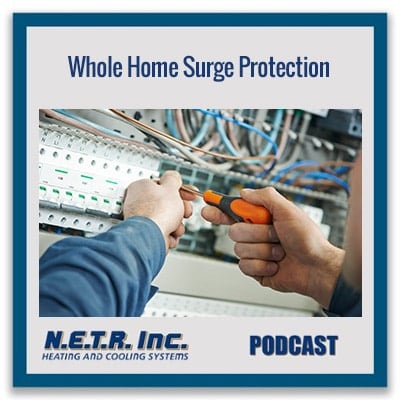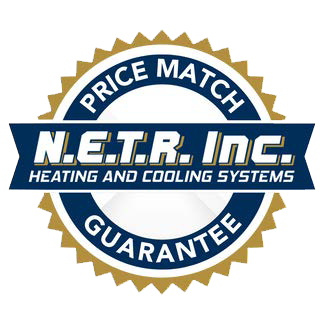
In this podcast, we talk about whole home surge protection. Learn how these systems work and how they protect your electronic devices. Then, look at added features such as built-in insurance coverage.
John Maher: Hi, I’m John Maher and I’m here today with Brett Rogenski, General Manager of N.E.T.R, a residential and commercial HVAC contractor in Massachusetts. And today we’re talking about whole home surge protection. Welcome, Brett.
Brett Rogenski: Hey. Thanks so much for having me, John.
What Is Whole Home Surge Protection?
John: Sure. So Brett, what is whole home surge protection and how does it differ from other types of surge protection systems?
Brett: That’s a super question, John. So yeah, whole home surge protection is a technology that we actually add on to a home’s electrical panel and it protects all the circuits and all the devices that are in the home. How that compares is what a lot of people think about as a surge protector is actually a plug-in device that protects what’s plugged into it.
So you would plug it into a wall outlet and then maybe have your stereo system or your television plugged into it or your computer. A whole home surge protection device, again, covers everything that’s electrical within the home through one centralized unit, which is added to the electrical panel.
How Whole Home Surge Protection Prevents Power Surges
John: And how does whole home surge protection help to prevent power surges? And what types of scenarios can that help to prevent?
Brett: Sure. So it’s interesting. So 60 to 80% of all power surges actually originate from within the home. So they’re caused by switching of electrical loads from power systems recovery and that sort of thing, and capacitors. So there’s a lot of stuff that can cause that. The other things that are more common are things like fluorescent light, ballast, HVAC systems, computers.
When they’re coupling, they actually tend to cause a surge in the line, and unfortunately if they have some of the failures in their internal components, they can actually cause a surge big enough to take out other things in the home.
The external sources are actually lightning, things coming from the grid, damaged power lines, or perhaps a surge coming from the actual production site. But 68% of them happen in the home.
So the whole home surge suppressor, by covering all of that, what it actually does is it can’t stop a surge, but it actually is sort of self-sacrificing and it eats the surge. So the technology that’s built in there when it feels that surge of power that’s going beyond the acceptable parameters, it actually absorbs that extra power and does not let it pass through to those devices plugged in your home’s electrical sockets.
Protecting All Electrical Devices in the Home
John: Okay. Are there any drawbacks or limitations to this type of surge protection system?
Brett: Really, you know what? There’s really not. It’s just a much more efficient and much more robust way of absorbing those power surges. Interestingly, there’s little micro surges that happen all day long in the power grid and in your home. It’s just that the equipment that’s tied to it is made to absorb certain ranges.
By adding a whole home surge protector, you’re now taking, first of all, it’s evening out that power. But the second thing it’s doing is when there’s a big surge that goes outside of those limits, it’s absorbing it instead of it being passed through to the electrical devices.
So no, there’s really no downside to it, you’re now protecting everything in the home that is electrically powered as opposed to certain things that are plugged into a power protecting strip, for instance.
Top Features
John: What are some of the key features or technologies that homeowners should look for when they’re researching a whole home surge protection system?
Brett: Sure. So a couple of things. The biggest one is how much power can it absorb? They usually measure that in joules. So essentially the higher the number, the better the device. So like most products, there’s a range of what you can purchase. So there are some that can absorb 60,000. There’s others that can absorb 120,000. The problem is, what happens is if you exceed that device’s capacity, the excess now flows through to your other devices that are put in.
So I guess what I would tell you is from an investment point of view, it’s not a lot more money to go with a premium product than it is a cheap product. So what we actually feature is a product that’s manufactured for us that is a premium product. It has a very high absorption rating for that excess electricity. The other thing is it has a very fast clamp down time, which means it’s able to recognize that surge extremely quickly and basically clamp down and take that extra power.
Others have a slower clamp down time, and that basically means that excess power is flowing through until it realizes it. So we invested in a product that has a very high rating in the amount of energy it can absorb. And then secondly in how fast it reacts to it.
Installing a Whole Home Surge Protector
John: How does the installation process work? What should homeowners expect?
Brett: Sure. Well at N.E.T.R., we use licensed electricians, so our licensed electricians would show up. We often sell these in conjunction with the installation of a new mini-split system because that’s a large electrically powered heating and cooling system that people should want to protect that investment. So what happens is our electricians arrive, they’re going to go down and they’re going to work on your electrical panel.
So they’re going to take off the front of the panel. They’re either going to look for an existing breaker they can marry to, or they will add a certain type of breaker to your panel, and then they will wire this device to that breaker and it’s now tied to your entire panel. So even though it’s tied to one breaker, it is essentially monitoring and protecting every single device that is, every single circuit in that panel. And then they close up your panel and test it and move on. So it’s really pretty inobtrusive.
Maintenance, Warranties, and Insurance
John: Do whole home surge protection systems require maintenance or is it like once they’re installed, you just set it and forget it?
Brett: For most people, it’s one and done. We come in, we put it in, we verify that it’s working correctly, and then you’ll probably never interact with it ever again in your life. It’s sitting down there doing its work happily, and you’ll probably never engage it again.
One of the features in the product that we particularly use does two things to let you know if it needs your attention. There’s a small sounder in it, so it will make a little chirping noise if it’s been negatively affected by a power surge and is no longer effective. So if a big power surge hit your house and it absorbed it, but it’s now been damaged because of that, it’ll start chirping at you. And it also has an LED light on it that will flash at you in red as opposed to its normal situation where it’s sitting there in a steady green.
So if you were to go down, look at your panel, it’d be mounted right next to your panel with a steady green light on it and it’s silent. If something happened and it did its job and absorbed all that energy but now is damaged, it’ll start chirping at you and it’ll give you a flashing red light that says, “Hey, help me.”
The great news, we were talking about differentiating products, is the product that we use comes with a lifetime warranty. And it’s transferable as well, as long as it’s in that home, if that product either fails or more likely, is damaged by a surge and needs a replacement, the manufacturer will replace it for free. So that’s a lifetime warranty.
The other thing is, and most don’t come with this, our product comes with a $100,000 insurance policy from the manufacturer to the homeowner. So in addition to it doing a great job in protecting everything there, in the event that it somehow failed and there was damage to your electronics, there’s a $100,000 policy in place from the manufacturer to the homeowner to replace those electronics. So it’s really, truly a great system.
Helps Prevent Power Outages Due to Surges
John: And so you said when a surge does happen, it may damage the surge protection system, but then you can get that replaced, but in the meantime, you’re still getting electricity to your home, so you’re not going to end up in a situation where a surge happens, it shuts down all of the electricity to your house, and now you have no electricity until you get this replaced or repaired or something like that.
Brett: That’s a great point, John, and yeah, absolutely. So that’s essentially a self-sacrificing item. So yeah, if for instance, you had a massive surge and it absorbed it, but it’s no longer effective, your electrical panel is still going to work, it’s simply that your surge protection device is no longer effective. And again, it’s going to notify you with that red light and that chirping, in which case we have printed right on those, our phone number, we’d want you to call us.
We’re going to get out there and replace it, and then us and the homeowner are going to work to get that credited back to the homeowner as well as, God forbid, it’s very unlikely, but if there was ever any damage that somehow made it past there, the manufacturer and the homeowner we’ll help them work together to file that insurance claim.
Surge Protectors Are an Investment Into Your Home
John: Do you have any final advice for homeowners who are considering a whole home surge protection system for their home?
Brett: I think it’s a tremendous investment that most homeowners should have and probably just never think about. If you look at all the devices that are electronic, as we kind of move to the electrification of everything, all those electronic devices that are running in your home, your refrigerator, your washer, your dryer, your computer, your ductless mini-split or your other HVAC components, surges can take out all of them. They all run on circuit boards now that are sensitive to surges.
So for a small investment, you can protect all of that, number one, from leaving you in a bad spot where they don’t work and having to replace them. And number two, God forbid, if you got hit with such a heavy surge that some of it was damaged, now you’re protected through an insurance policy with that manufacturer.
Contact NETR, Inc to Get Help Today
John: All right. Well that’s great information, Brett. Thanks again for speaking with me today.
Brett: Thanks so much, John.
John: And for more information, you can visit the N.E.T.R website at netrinc.com or call 781-933-NETR. That’s 781-933-6387.
